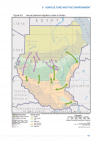I came across one of the most unexpectedly great locations for a civilization. In the geographical heart of Africa.

Depending on the criteria used these are the geographical centers of Africa. Between points 1,3 and 4 lies the land between the Uelé and Mbomu rivers. One of the main reasons civilization didn't develop inside the congo rainforest is that the soils are infertile and can't sustain high population densities.
Well this particular area has fertile nitisols perfect for growing crops like plantain and yam. Two of the tropical crops that can be harvested all year long thus allowing for huge population densities.

The dark areas represent the fertile soils of Africa, note the area circled in red.
It's central position would also allow the civilization to trade with 3 major river basins Lake Chad, the Nile and the Congo.
 Allowing it's people to trade with the civilizations of the Horn, West Africa, the Nile, Lake Chad and later on the Congo.
Allowing it's people to trade with the civilizations of the Horn, West Africa, the Nile, Lake Chad and later on the Congo.
In the OTL some of the ancestors of the present day inhabitants of this area might have been the first users of iron and made the bouar megaliths. They migrated from the west of the Central African Republic. https://www.researchgate.net/public..._of_African_Metallurgies_Summary_and_Keywords
In regards to resources the area has vast supplies of diamond, gold, ivory, furs and even a domesticable silk moth.
What are some other surprisingly great locations for a civilization that didn't have one?
Depending on the criteria used these are the geographical centers of Africa. Between points 1,3 and 4 lies the land between the Uelé and Mbomu rivers. One of the main reasons civilization didn't develop inside the congo rainforest is that the soils are infertile and can't sustain high population densities.
Well this particular area has fertile nitisols perfect for growing crops like plantain and yam. Two of the tropical crops that can be harvested all year long thus allowing for huge population densities.
The dark areas represent the fertile soils of Africa, note the area circled in red.
It's central position would also allow the civilization to trade with 3 major river basins Lake Chad, the Nile and the Congo.
In the OTL some of the ancestors of the present day inhabitants of this area might have been the first users of iron and made the bouar megaliths. They migrated from the west of the Central African Republic. https://www.researchgate.net/public..._of_African_Metallurgies_Summary_and_Keywords
In regards to resources the area has vast supplies of diamond, gold, ivory, furs and even a domesticable silk moth.
What are some other surprisingly great locations for a civilization that didn't have one?
